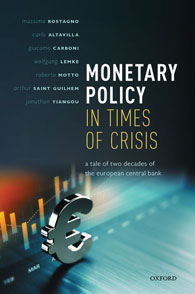Monetary Policy in Times of Crisis:
A Tale of Two Decades of the European Central Bank

Massimo Rostagno, Carlo Altavilla, Giacomo Carboni, Wolfgang Lemke, Roberto Motto, Arthur Saint Guilhem, and Jonathan Yiangou
Oxford University Press
Oxford,
UK, 2021, 448 pp., $115
The European Central Bank (ECB) has its share of detractors and skeptics who say the institution doesn’t do enough or is too frequently “behind the curve,” in market parlance. Monetary Policy in Times of Crisis is more than a strong defense. Written by a team at the ECB, it is a unique exposition, laid out more transparently than by any other advanced economy central bank, of the analysis that draws from theory and models to inform the deliberations of its governing council’s monetary policy decisions. Readers will be impressed with what is under the hood—the science and art that go into monetary policymaking.
The authors provide a masterful analysis of the monetary policy challenges this young institution faced in its first two, unusually eventful and crisis-prone, decades and how it grappled with a monetary union still in the making. Most are familiar with President Mario Draghi’s 2012 “whatever it takes” dictum, which addressed the existential threat to the euro, but few will be aware of the ECB’s behind-the-scenes effort in pushing early for the creation of the European Stability Mechanism, which made its (never used) Outright Monetary Transaction instrument effective in resolving the euro area crisis. The ECB also takes credit for the creation of a unified banking supervision system that reduced fragmentation and made its monetary policy more effective across the monetary union.
The array of instruments the ECB uses—negative interest rates, asset purchases, subsidized loans to banks for onlending, and forward guidance on policy rates—typically begs the question of why its strategy is more complex than that of other central banks. This book provides strong empirical evidence on the complementarity between these instruments in delivering an accommodative monetary stance, and especially how these instruments together contain pressure on longer-term borrowing costs. Detractors will, of course, point to other central banks that achieve similar outcomes with a smaller arsenal. That may, however, miss the important nuance that the ECB is operating in a currency union with very diverse financial imbalances among sovereigns and banks across the euro area. Low interest rates would not be evenly transmitted to the entire euro area if the ECB did not subsidize lending to weaker banks.
The ECB’s continued difficulty meeting its price stability objective remains a concern and argues for continuing its accommodative stance. But here, too, the analysis is persuasive in showing that using this array of instruments has stemmed the decline in longer-term inflation expectations. In other words, the counterfactual would have been worse.
Though the analysis in this book covers the period to the end of 2018, the authors make a convincing case that the policy tools developed over the past decade have been instrumental in enabling the ECB to respond quickly and forcefully to the COVID-19 pandemic. The wealth of analysis here will appeal to a much wider audience than just the experts.
Opinions expressed in articles and other materials are those of the authors; they do not necessarily reflect IMF policy.








